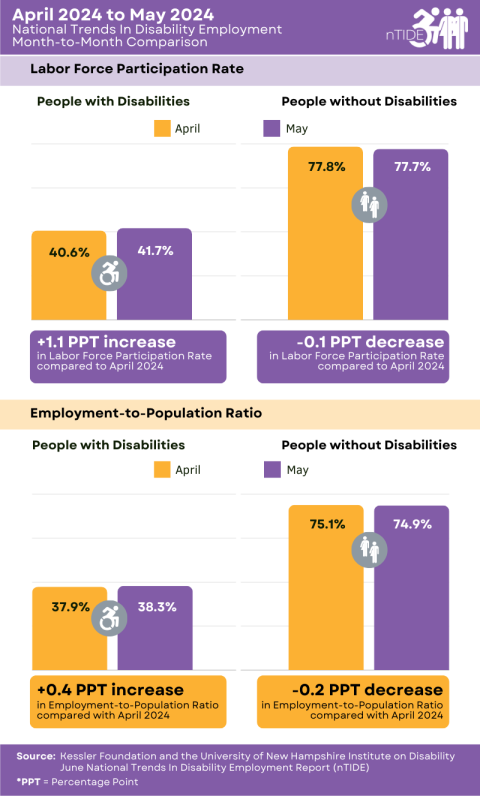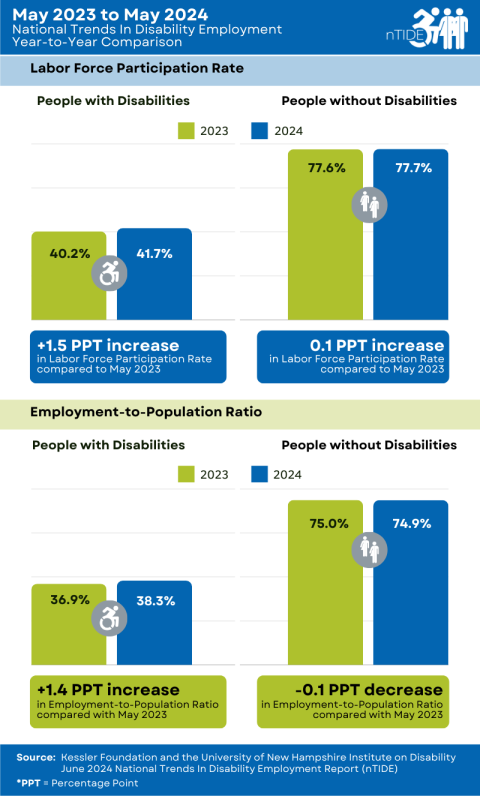
Join us for the next nTIDE Lunch & Learn Webinar featuring guest presenters Kimberly Knackstedt from Unlock Access, LLC and Jenny Leland from Starbucks.
nTIDE May 2024 Jobs Report: People with Disabilities Succeeding in Finding Jobs
National Trends in Disability Employment (nTIDE) – Issued semi-monthly by Kessler Foundation and the University of New Hampshire
June 7, 2024 – May job numbers showed gains for people with disabilities, who continue to engage with the labor market at historic levels, according to today’s National Trends in Disability Employment – semi-monthly update (nTIDE), issued by Kessler Foundation and the University of New Hampshire’s Institute on Disability (UNH-IOD). Increases in both labor force participation and employment indicate that people with disabilities are not only striving to work but succeeding in finding jobs. Both indicators remained flat for people without disabilities.
Month-to-Month nTIDE Numbers (comparing April 2024 to May 2024)

This graphic compares the labor market indicators for April 2024 and May 2024, showing increases in the labor force participation rate and the employment-to-population ratio for people with disabilities. Both indicators decreased slightly for people without disabilities.
Based on data from the U.S. Bureau of Labor Statistics (BLS) Jobs Report released today, the labor force participation rate for people with disabilities (ages 16-64) increased from 40.6 percent in April 2024 to 41.7 percent in May 2024 (up 2.7 percent or 1.1 percentage points). For people without disabilities (ages 16-64), the labor force participation rate decreased from 77.8 percent in April 2024 to 77.7 percent in May 2024 (down 0.1 percent or 0.1 percentage points). The labor force participation rate reflects the percentage of people who are in the labor force (working, on temporary layoff (on furlough), or actively looking for work in the last four weeks) relative to the total population (the number of people in the labor force divided by the number of people in the total population multiplied by 100).
“People with disabilities are engaging in the labor market, either working or actively looking for work, at historically high rates,” said Andrew Houtenville, PhD, professor of economics and research director of the UNH-IOD. “This trend may reflect opportunities for employment given labor market shortages in many parts of the country, although it may also reflect people seeking to support themselves and their families given recent increases in the cost of living,” he added.
In May, the employment-to-population ratio for people with disabilities (ages 16-64) increased from 37.9 percent in April 2024 to 38.3 percent in May 2024 (up 1.1 percent or 0.4 percentage points). For people without disabilities (ages 16-64), the employment-to-population ratio decreased from 75.1 percent in April 2024 to 74.9 percent in May 2024 (down 0.3 percent or 0.2 percentage points). The employment-to-population ratio, a key indicator, reflects the percentage of people who are working relative to the total population (the number of people working divided by the number of people in the total population multiplied by 100).
“People with disabilities saw gains in their employment-to-population ratio and labor force participation rate,” noted John O’Neill, PhD , director of the Center for Employment and Disability Research at Kessler Foundation. “Together, these increases show that people with disabilities continue to strive for work and are succeeding in finding jobs,” he added.
Year-to-Year nTIDE Numbers (comparing May 2023 to May 2024)

This graphic compares the labor market indicators for May 2023 and May 2024, showing increases in the employment-to-population ratio and labor force participation rate for people with disabilities. For people without disabilities, the employment-to-population ratio declined slightly, and the labor force participation rate increased.
The employment-to-population ratio for people with disabilities (ages 16-64) increased from 36.9 percent in May 2023 to 38.3 percent in May 2024 (up 3.8 percent or 1.4 percentage points). For people without disabilities (ages 16-64), the employment-to-population ratio decreased from 75.0 percent in May 2023 to 74.9 percent in May 2024 (down 0.1 percent or 0.1 percentage points).
The labor force participation rate for people with disabilities (ages 16-64) increased from 40.2 percent in May 2023 to 41.7 percent in May 2024 (up 3.7 percent or 1.5 percentage points). For people without disabilities (ages 16-64), the labor force participation rate also increased from 77.6 percent in May 2023 to 77.7 percent in May 2024 (up 0.1 percent or 0.1 percentage points).
In May, among workers ages 16-64, the 6,490,000 workers with disabilities represented 4.3 percent of the total 150,139,000 workers in the U.S.
Ask Questions about Disability and Employment
Each nTIDE release is followed by an nTIDE Lunch & Learn online webinar. This live broadcast, hosted via Zoom Webinar, offers attendees Q&A on the latest nTIDE findings, provides news, updates from the field, and features invited panelists who discuss current disability-related findings and events.
On June 7, 2024, at 12:00 pm – 1:00 pm Eastern, guest presenters Kimberly Knackstedt, PhD, of Unlock Access LLC and Jenny Leland, MA, of Starbucks, join Drs. O’Neill and Houtenville and Cindy Smith, MS, JD, director of public policy at AUCD. Join our free Lunch & Learn live or visit the nTIDE archives at: ResearchonDisability.org/nTIDE. Also, register now for our mid-month nTIDE Deeper Dive into employment trends at nTIDE Deeper Dive – 06/21/2024.
